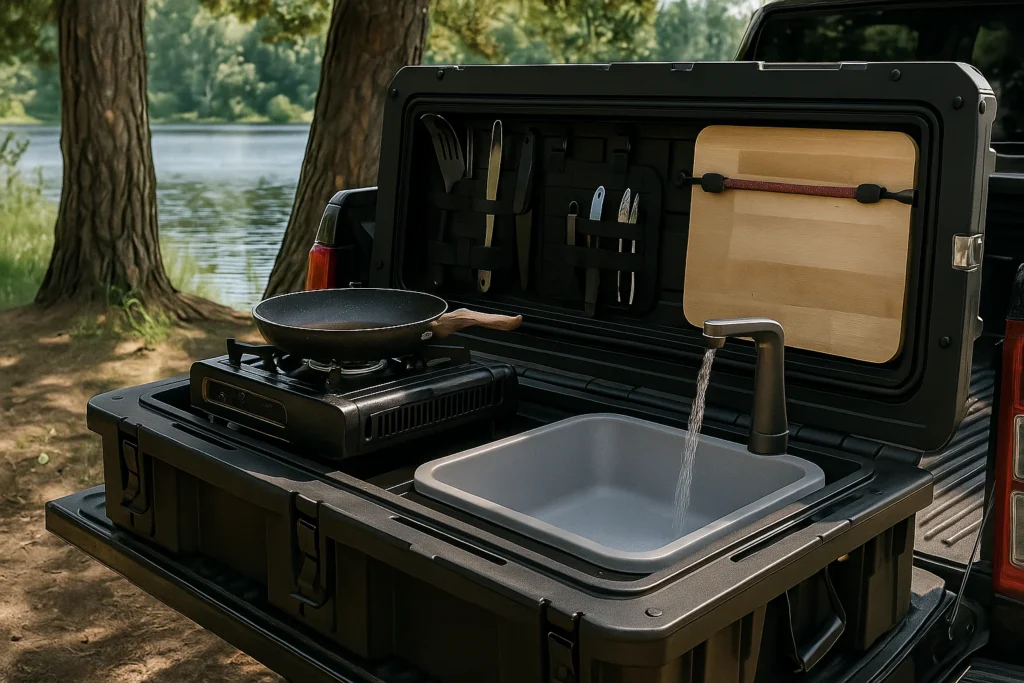For decades, the standard camping experience has followed a familiar script: a picnic table, a Coleman stove, a few plastic tubs of scattered gear, and a cooler. Meals are often more about managing chaos than enjoying the outdoors. But in recent years, that model has started to shift. More and more campers—especially those who travel frequently or off-grid—are swapping out piecemeal setups for a more complete and efficient solution: the camp kitchen.
These self-contained cooking systems, which bundle stoves, sinks, prep surfaces, and utensils into a single rugged unit, are quickly becoming the go-to option for outdoor meals. The rise of overlanding, car camping, and vanlife has pushed innovation forward, with campers now seeking the same reliability and convenience they expect at home—just scaled down and made trail-ready.
“Once you use an all-in-one camp kitchen, it’s hard to go back to bins and folding tables,” says Sam Delaney, a full-time road traveler and outdoor gear tester. “You can cook faster, cleaner, and with a lot less frustration.”
So, is the traditional approach to camp cooking fading into history? And is the camp kitchen truly the new standard for outdoor food prep? The answer might surprise long-time campers—and it’s worth exploring why this shift is happening now.
The Problem with Traditional Camp Cooking
For many campers, cooking outdoors has always been a patchwork operation. Plastic bins hold mismatched cookware and utensils, old propane stoves require constant cleaning, and cleanup often means washing dishes in cold water at a shared campground sink—or worse, using a water bottle and a towel on a folding table.
This approach works, but it’s far from efficient. Gear is often misplaced, forgotten, or broken in transit. And when it’s time to pack up, repacking everything properly can take as long as the meal itself.
More importantly, traditional setups don’t always support the evolving ways people camp. With the rise of dispersed camping and the growth of national forest use, fewer travelers are staying at sites with picnic tables, sinks, or built-in fire pits. They’re camping further from infrastructure—and they need gear that can keep up.
Enter the All-in-One Camp Kitchen
The all-in-one camp kitchen solves many of these problems with a streamlined design. By bundling essentials into one case, these portable kitchens make setup fast, organized, and consistent—no matter where you’re camping.
A typical model might include:
- A built-in butane or propane stove
- A collapsible sink with a rechargeable water faucet
- A cutting board, prep area, and cleaning brushes
- Organized compartments for utensils, cutlery, and cookware
- Space for dry goods, spices, and cooking fuel
Some, like the units offered by CampKitchen.us, also include plates and cups for four people, LED lighting, and secure closures that keep everything safe during transport.
“These newer systems are designed around how people actually cook and live outdoors,” says outdoor equipment designer Laura McKinley. “It’s not just about making food—it’s about making the experience smoother from start to finish.”
Designed for Today’s Campers
The new generation of campers isn’t just spending a night in the woods—they’re cooking multi-course meals at trailheads, tailgates, and rest stops. They want fresh food, clean prep spaces, and systems that work whether they’re in a national park or pulled over on BLM land.
Camp kitchens deliver that by offering home-like utility without the bulk or setup time. With the entire kitchen packed in a weatherproof box, campers no longer need to unpack multiple containers or rely on unpredictable site amenities.
As a result, all-in-one camp kitchens are quickly gaining traction not just among overlanders and vanlifers, but also weekend campers, families, and full-time travelers.
Also read: From Kitchen Novice to Home Chef Through Local Cooking Classes







